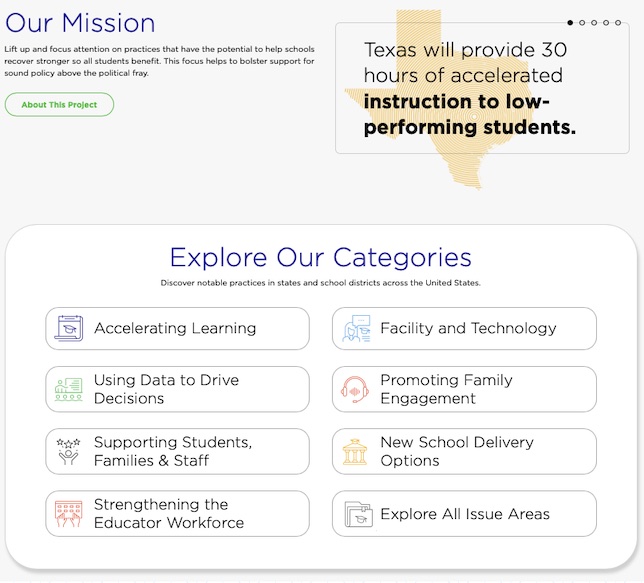New EduRecoveryHub Site Showcases Best Practices in K–12 COVID Recovery Spending
- By Kristal Kuykendall
- 01/26/22
A new website launched today showcases emerging best practices in how K–12 school districts are using federal pandemic recovery education funds, along with expert analysis from varying perspectives on what makes each effort stand out.
EduRecoveryHub, a joint project of the Collaborative for Student Success, the Center on Reinventing Public Education, and Georgetown University’s Edunomics Lab, aims to help school leaders learn from their peers by focusing on practices that “have the potential to help schools recover strong and all students benefit,” according to the website.
The EduRecoveryHub includes a state-by-state list of spending plans for the $189 billion in COVID education relief funds dedicated to K–12, and it links to each state education department’s detailed plans and impact reporting by county and/or district.
The headliner of the EduRecoveryHub website is its Practices in Focus section, searchable by topic:
- Promoting family engagement
- Supporting students, families, and staff
- Facility and technology
- Using data to drive decisions
- Accelerating learning
- Strengthening the educator workforce
- New school delivery options
At launch time, the website featured 25 Practices in Focus from across 13 states, some featuring statewide initiatives and others district-specific. Practices in Focus featured on EduRecoveryHub range from innovative ways to address student mental health needs to district- and statewide plans to accelerate academic learning.
Each practice showcased on the site includes a brief summary of the program, analyses from experts on why the practice is particularly effective or worthy of emulation, and a link to more details from the state or district being highlighted.
For example, an entry on Boston Public Schools said the district “plans to distribute federal recovery funds directly to schools based on clear definitions of student needs. This approach gives principals the flexibility to respond to needs in their schools and to pilot new solutions, yet ensures that recovery funds are targeted to buildings that need it most. The district used a Racial Equity Planning Tool to determine allocations. This tool disaggregates student achievement data on standardized assessments by race, students with disabilities, former and current English learners, and students who are economically disadvantaged.
“We are spotlighting this because using a data-driven approach to the distribution of federal relief funds, then providing principals with maximum flexibility to address their specific local challenges, is an innovative approach to meeting student needs,” EduRecoveryHub’s entry on Boston Public Schools said. “The use of an equity tool to target resource allocation is also noteworthy.”
Below the summary are one-sentence “reviews” from experts at Learning Heroes, National Parents Union, The Rural Alliance, and others.
“By spotlighting these examples, and the experts who support expansion of these efforts, the hub will help inform use of relief funding across the country,” said a news release from EduRecoveryHub. “The nation has a one-time opportunity to learn from the disruptions in public schools brought about by COVID-19 and focus recovery efforts and resources on delivering high-quality instruction and supports for students to accelerate learning and meet their social and emotional needs.”
The EduRecoveryHub will be frequently updated with resources, practices, expert commentary, and news to highlight ongoing efforts across America to spark progress and improvements in school systems, the organizations said, noting that website is intended to be interactive, solicit feedback, and increase transparency, but not as an “endorsement of a state or district’s recovery efforts.”
“The federal investment represents a once-in-a-generation opportunity for school districts to help students re-engage in school, get back on track in reading and math, and earn sufficient credits to graduate ready for college or career,” Edunomics Lab Policy Director Chad Aldeman said in the news release. “In the wake of the pandemic, we are seeing districts use funds in new ways to address challenges and improve student outcomes. These savvy, nimble investments may catch on in other communities and help propel students forward.”
The site will soon include an open invitation so that other organizations and experts can weigh in as well. It already includes a “Submit a Practice” link for website visitors to submit a district- or statewide education recovery practice for review and consideration to be showcased.

About the Author
Kristal Kuykendall is editor, 1105 Media Education Group. She can
be reached at [email protected].